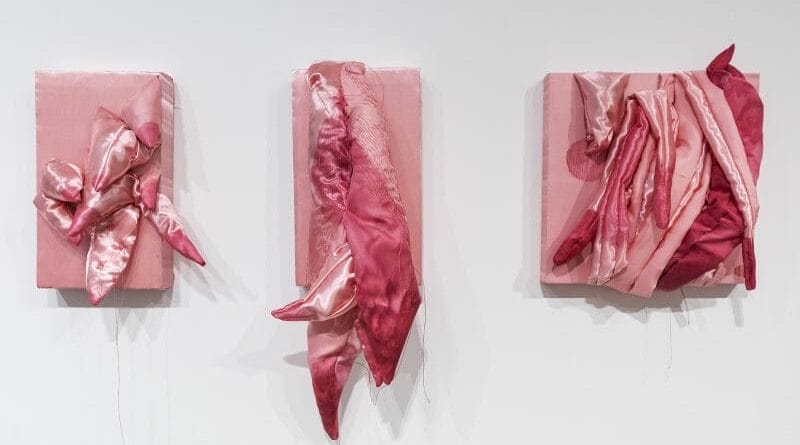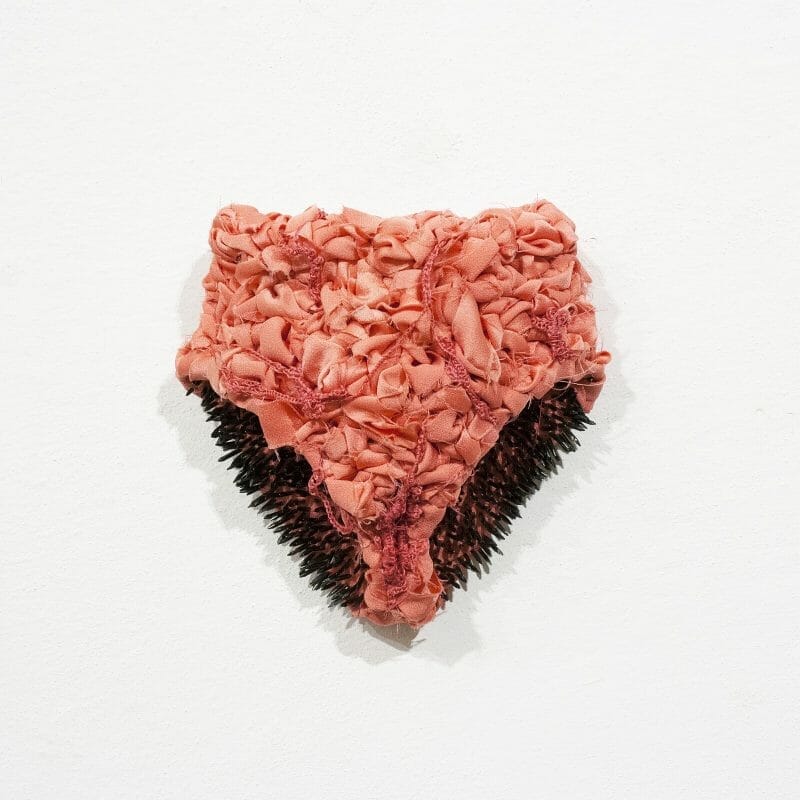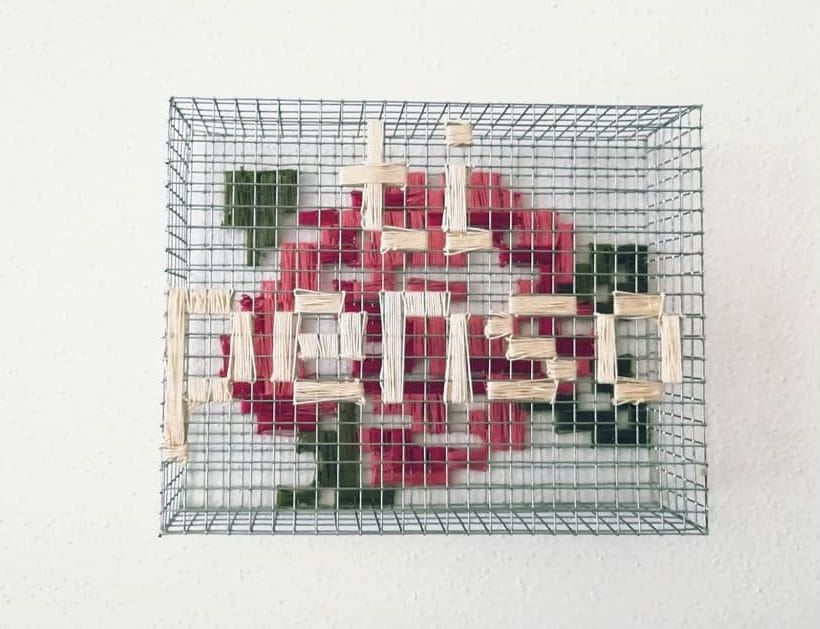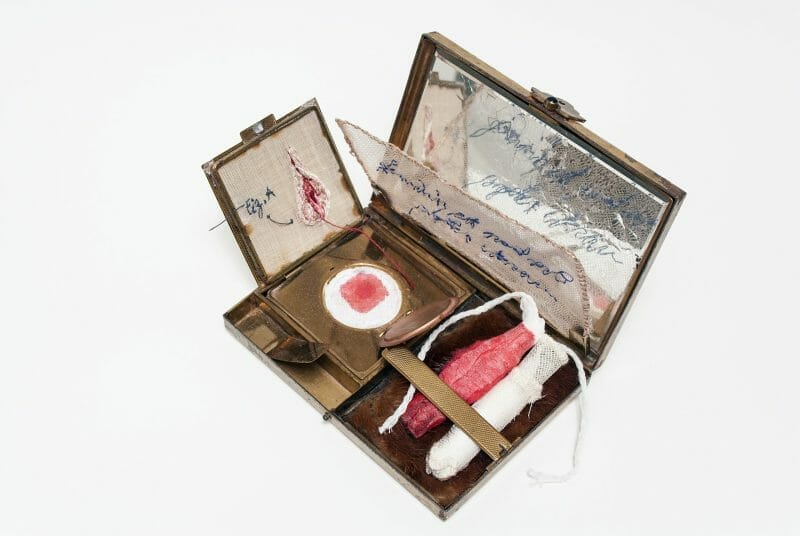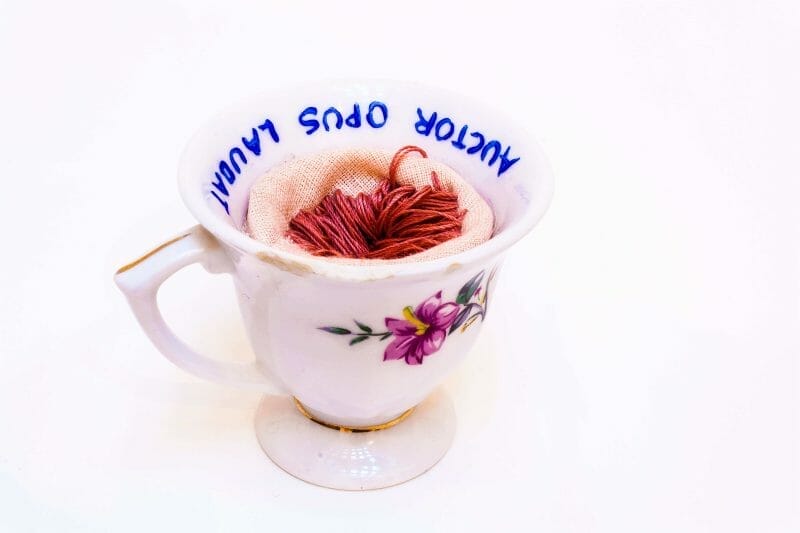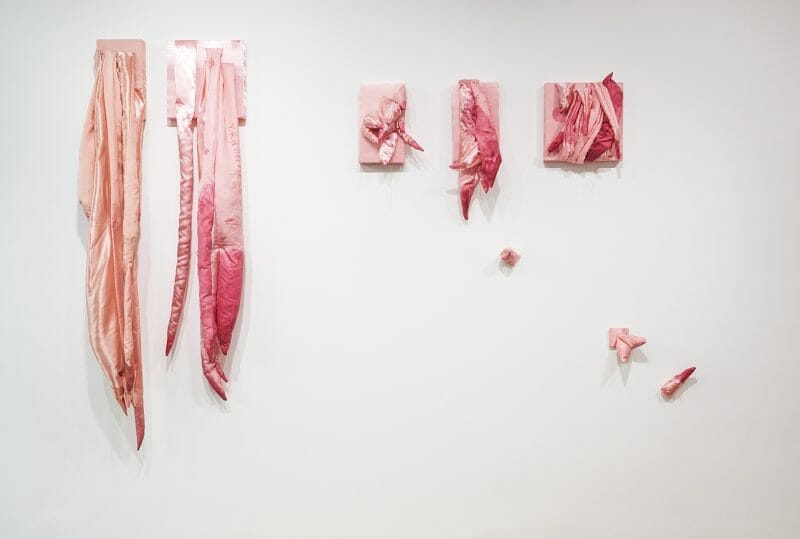An intimate investigation into female bodies through the re-discovery of emblematic everyday objects: an interview with Rosita D’Agrosa.
*Featured photo: Bowels project – mix media, istallazione , 2019. Courtesy Rosita D’Agrosa
At the center of Rosita D’Agrosa’s work we find the female body and the changes it undergoes. Textile sculptures, site-specific installations and pictorial works follow one another in the artist’s production who mixes different materials and techniques, maintaining a visual and conceptual coherence without ever repeating itself. The presence of the object and its ability to convey a meaning are fundamental aspects of her artistic research. Trained at the Academy of Fine Arts in Florence, the city where she lives and works, D’Agrosa has participated in numerous group and personal exhibitions.
In your works, which are presented in series form, there is a recurring reference, as delicate as it is explicit, to an element connected to the body dimension: why did you choose this theme of investigation?
Much of my artistic research focuses on the body, specifically my body, a female body, in an attempt to make the latter a portrait of a free and profound intimacy. The representation of the vulva: embroidered, made with fabrics or painted, over the years it has become, together with the icon of the uterus or underpants, an emblem of my poetics. I started investigating this theme with the Mutatis MutandA series, consisting of 28 panties like the 28 days of the menstrual cycle, in each pant the praise to femininity and change appears in the form of a metaphor: a rosebud, a spoon, an embroidery or a drawing that alludes to the shape of the vulva, uterus or ovaries. The choice of this subject was little reasoned, but a simple intuition: I am talking about the female body and what revolves around its existence, its sexuality and simple everyday life. Talking about it through a genre icon was anything but revealing a taboo.
Reproductions of sanitary pads, underwear and reproductive organs are part of your works. How do you choose your subjects and how is the work of art born?
The work of art originates from the objects I use, my personal objets trouvés: cups, spoons, underpants, powder cases, mirrors, linen cloths (the old sanitary napkins) or sheets from my family kit. These are objects already full of meaning and their own history. They allow me to reinvent a poetics of the ordinary around them. Using these objects, extrapolated from the everyday context, my intention is to personify the intimate female dimension, inter-union and personal: the fil rouge that accompanies all my research. They are worked and reworked through textile practices, such as embroidery or crochet. Another important element is precisely the textile technique that binds the object to the subject, for example in the series of Breakfasts on the grass, embroidery of the uterus inside coffee cups displayed in small cloches as if they were sweets displayed in a pastry shop. Often the subjects arise from reflections, facts, events, bonds and objects that animate the everyday life of my reality, therefore, mine is a simple transposition of a slice of life, a fragment of experience deposited through allegories of the female world, almost like a play on words or associations.
Do you think art can be a tool capable of tackling taboos, preconceptions and stereotypes that still survive on the female universe?
Yes! Surely art for an artist can be a communication and language tool through which to break taboos, preconceptions and stereotypes, especially those that unfortunately still survive in the female universe. This is exactly what I try to do in my work: breaking down walls, using art as a tool for expression, freedom, dialogue, narration and testimony.
Pale pink, fuchsia, red are recurring shades in your work, what meanings do they have for you?
The shades of red, magenta, pink represent me, allowing me to chromatically recreate an intimate, corporal, carnal, organic dimension. I use red especially for the works on paper entitled Heart project which are presented as sheets on which I deposit my “emotional notes”, the watercolor background is an icon of the heart ‘shape’: the heart summarized in a stain is represented in the moment in which it contracts in the heartbeat, consequence of a certain emotion. Pink ironically takes over in the series of soft sculptures entitled Bowels project which portray entrails: our intestines idealized, refined, softened and ridiculed in its representation. The color, in fact, suggests a playful reading of the work, presenting itself as a huge tangle of pink tentacles that dangle from the walls to the floor. These colors have contradictory and harmonious connotations between them, they can express power and strength, delicacy and intimacy, carnality, comfort, joy, irony and for me they are nothing more than a series of unlimited ‘environments’ of representation.
In the Jaulas para pensamientos series, there are phrases like “I miss you” and “I think of you”. In a society in which the image seems to have a decisive role for individuals, what importance do you attribute to the written word and its ability to express emotions?
I like to describe the written word as a “graphic expression” of the linguistic code, it allows the meaning of the written content to remain immutable and immobile over time. Thanks to its ability not to lose but to acquire importance, the written word becomes a “deposit” in my imagination. I have worked a lot in the past on the concept of a footnote, in fact,an annotation … we write down everything that needs to be remembered and that is important. In my works, the written word is constantly and rhythmically present: first of all as a graphic element, as a sign and for the function of being a key to reading the story, it is often embroidered. In this regard, in the series Jaulas para pensamientos, or “cages for thoughts”, the written word is transformed into an image, the message is simple, easy to read poetic. Born in 2020 during the lockdown period, this series was made with the only material I had available at that time: the wire mesh, with a meditative and therapeutic purpose, I began to embroider my thoughts, my feelings. Through weaving, everything that at that moment was repressed and internally caged, was transformed, thus becoming a gift for the Other. Light, aerial, flowery cages, as a container for messages (in a bottle) to be sent to loved ones. “MI MANCHI”, “TI PENSO”, “ODI ET AMO” (“I MISS YOU”, “I THINK OF YOU”, “ODI ET AMO”) are all short text messages, like text messages sent from mobile phones with the aim of virtually filling the great void that isolation has forced us to savor.
Can you tell us how the series Le colazioni sull’erba (The breakfasts on the grass) was born and what does it want to communicate?
The series The breakfasts on the grass is inspired by two different works: Le dejeuneur sur l’erbe by Manet and the surreal Breakfast in fur by Meret Oppenheim. From both works, I have extrapolated the key elements of rupture and scandal that have contributed to making them “revolutionary”.For Manet’s work, the homage to the title was an easy and traceable allusion to the sensation that the work had caused at the time. The reference to Oppenheim’s work is due to the desire to recreate a sense of displacement, discomfort, desire and repulsion. This is how my Breakfasts on the grass were born.
They appear as microcosms inside small choche da petite patisserie: cups with an embroidered uterus inside entitled FIG. A, compact mirrors with the embroidery of a vulva with the Latin quote “Nosce te ipsum” (know yourself), dessert plates with moths inside or thorns to swallow. They are details of intimate stories.
As an artist, how do you perceive contemporary art today? Is there any artist who influenced your research?
I think I perceive contemporary art as if it were balanced on a thread suspended in the void. Solid foundations of my artistic research are undoubtedly: Louise Bourgeios, Gina Pane, Marina Abramovic, Cy Twombly, Meret Oppenheim, Robert Gober, Marcel Duchamp, Tracey Emin, Christian Boltanki.
What are you working on now and what are your future projects?
Right now I am working on new projects and experimenting with new approaches to textile practices. I am experimenting with the complete deconstruction of my work, in order to extrapolate a small portion from which to start over. This “destructive” mode is recurring in my creative process. At the same time I enrich my series with new elements, I will present them in the next exhibition projects scheduled for sometime in the fall.
